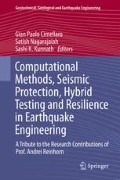Abstract
Earthquakes and extreme events in general cause direct and indirect economic effects on every major economic sector of a given community. These effects have grown in the last years due to the increasing interdependency of the infrastructures and make the community more vulnerable to natural and human-induced disruptive events. Therefore, there is need for metrics and models which are able to describe economic resilience, defined as the ability of a community affected by a disaster to resist at the shock and bounce back to the economy in normal operating conditions. Several attempts have been made in the past to achieve a better measurement and representation of the economic resilience and to find suitable metrics to help decision planning. The most popular methodologies are based on Computable General Equilibrium models (CGE) and Inoperability Input-Output models (IIM). In this study, we analyze these methods, showing advantages and limitations. Finally, a new method is proposed to evaluate economic resilience which is based on equilibrium growth models and compared with other approaches on a specific case study: the San Francisco Bay Area.
Access this chapter
Tax calculation will be finalised at checkout
Purchases are for personal use only
References
Boisvert RN, Kay D, Turvey CG (2012) Macroeconomic costs to large scale disruptions of food production: the case of foot- and-mouth disease in the United States. Econ Model 29(5):1921–1930
Chamberlain Economics, L. L. C. (2011) Methodology paper: developing square U.S. input-output tables from B.E.A. make and use tables, pp 1–4
Cimellaro GP, Reinhorn AM, Bruneau M (2010a) Framework for analytical quantification of disaster resilience. Eng Struct 32(11):3639–3649
Cimellaro GP, Reinhorn Andrei M, Bruneau M (2010b) Seismic resilience of a hospital system. Struct Infrastruct Eng 6(1–2):127–144
Cimellaro GP, Villa O, De Stefano A (2013) Serviceability of natural gas distribution networks after earthquakes. J Earthq Tsunami 7(2):22
Cimellaro GP, Tinebra A, Renschler C, Fragiadakis M (2014a) Resilience-based design of an urban water distribution system. J Struct Eng ASCE (in review)
Cimellaro GP, Villa O, Bruneau M (2014b) Resilience-based design of natural gas distribution networks. J Infrastruct Syst ASCE. doi:10.1061/(ASCE)IS.1943-555X.0000204
Davidson R, Çagnan Z (2004) Restoration modeling of lifeline systems. Research progress and accomplishments 2003–2004. Multidisciplinary Center for Earthquake Engineering Research, Buffalo
Haimes Y, Jiang P (2001) Leontief-based model of risk in complex interconnected infrastructures. J Infrastruct Syst 7(1):1–12
Konovalchuk V (2006) A computable general equilibrium analysis of the economic effects of the Chernobyl nuclear disaster. The Graduate School College of Agricultural Sciences. The Pennsylvania State University
Leontief W (1966) Input-output economics. Oxford University Press, New York
Li W (2010) A structural growth model and its applications to Sraffa’s system. In: 18th international input-output conference, Sydney
Lian C, Haimes YY (2006) Managing the risk of terrorism to interdependent infrastructure systems through the dynamic inoperability input–output model. Syst Eng 9:241–258
Miles SB, Chang SE (2003) Urban disaster recovery: a framework and simulation mode. Technical report MCEER-03-0005. Multidisciplinary Center for Earthquake Engineering Research, University at Buffalo, The State University of New York, Buffalo
Mitra-Kahn BH (2008) Debunking the myths of computable general equilibrium models. SCEPA Work Pap 1:1–93
Oliva G, Panzieri S, Setola R (2010) Agent-based input-output interdependency model. Int J Crit Infrastruct Prot 3(2):76–82
Pant R, Barker K (2012) Building dynamic resilience estimation metrics for interdependent infrastructures. In: Proceedings of the European safety and reliability conference, Helsinki, June 2012
Pant R, Barker K, Grant FH, Landers TL (2011) Interdependent impacts of inoperability at multimodal transportation container terminals. Transp Res Part E Logist Transp 47(5):722–737
Pant R et al (2013) Static and dynamic metrics of economic resilience for interdependent infrastructure and industry sectors. Reliab Eng Syst Saf
Renschler C, Frazier A, Arendt L, Cimellaro GP, Reinhorn AM, Bruneau M (2010) Framework for defining and measuring resilience at the community scale: the PEOPLES resilience framework. MCEER technical report MCEER-10-006. University at Buffalo, The State University of New York, Buffalo
Rose A (2009) Economic resilience to disasters. Community and Regional Resilience Institute report no 8, Oak Ridge
Rose A, Liao S (2005) Modeling resilience to disasters: computable general equilibrium analysis of a water service disruption. J Reg Sci 45(1):75–112
Rutter M (2012) Resilience as a dynamic concept. Dev Psychopathol 24(2):335–344
Santos JR, Haimes YY (2004) Modeling the demand reduction input-output (I-O) inoperability due to terrorism of interconnected infrastructures. Risk Anal 24:1437–1451
Shoven JB (1992) Applying general equilibrium. Cambridge University Press, Cambridge
Stokols D, Lejano R, Hipp J (2013) Enhancing the resilience of human-environment systems: a social ecological perspective. Ecol Soc 18(1):7
Terzic V, Mahin SA, Comerio MC (2014) Comparative life-cycle cost and performance analysis of structural systems. In: Proceedings of the 10th national conference in earthquake engineering, earthquake engineering research institute, Anchorage
Wing IS (2004) Computable general equilibrium models and their use in economy-wide policy analysis. Technical note, Joint Program on the Science and Policy of Global Change. MIT
Acknowledgments
The research leading to these results has also received funding from the European Community’s Seventh Framework Programme – Marie Curie International Reintegration Actions-FP7/2007–2013 under the Grant Agreement n° PIRG06-GA-2009-256316 of the project ICRED – Integrated European Disaster Community Resilience, and by the Marie Curie International Outgoing Fellowship (IOF) Actions-FP7/2007–2013 under the Grant Agreement n°PIOF-GA-2012-329871 of the project IRUSAT – Improving Resilience of Urban Societies through Advanced Technologies.
Author information
Authors and Affiliations
Corresponding author
Editor information
Editors and Affiliations
Rights and permissions
Copyright information
© 2015 Springer International Publishing Switzerland
About this chapter
Cite this chapter
Cimellaro, G.P., Martinelli, D. (2015). Modelling Economic Dimension of Community Resilience. In: Cimellaro, G., Nagarajaiah, S., Kunnath, S. (eds) Computational Methods, Seismic Protection, Hybrid Testing and Resilience in Earthquake Engineering. Geotechnical, Geological and Earthquake Engineering, vol 33. Springer, Cham. https://doi.org/10.1007/978-3-319-06394-2_11
Download citation
DOI: https://doi.org/10.1007/978-3-319-06394-2_11
Published:
Publisher Name: Springer, Cham
Print ISBN: 978-3-319-06393-5
Online ISBN: 978-3-319-06394-2
eBook Packages: Earth and Environmental ScienceEarth and Environmental Science (R0)

